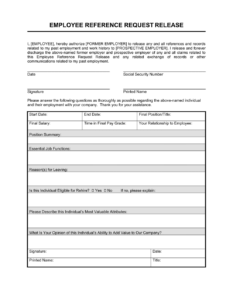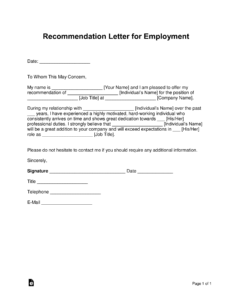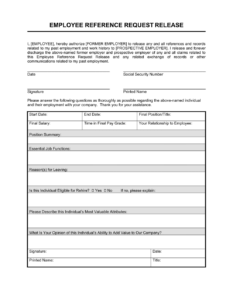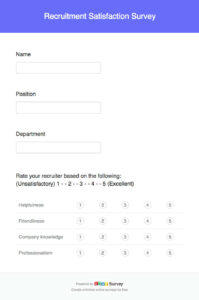Using a structured approach offers several advantages. It ensures that all pertinent information is collected, reducing the risk of overlooking critical details. This structured format also simplifies comparisons between candidates, facilitates objective assessment, and promotes a fair and consistent hiring process. Additionally, it can save significant time and resources by eliminating the need to create individual requests for each reference.
This foundation of efficient and effective reference checking plays a crucial role in making informed hiring decisions. The following sections will delve deeper into the essential components of these forms, best practices for their utilization, and legal considerations for employers.
Key Components of a Reference Request Form
Effective reference checks rely on comprehensive information gathering. Well-designed forms ensure consistency and efficiency in this process. The following components are crucial:
1. Candidate Information: This section identifies the individual being assessed and includes their name, the position they applied for, and contact information. This allows the referee to connect the request to the correct applicant.
2. Requestor Information: Details about the organization requesting the reference, including the company name, contact person, and their contact information, are essential for establishing credibility and enabling direct communication.
3. Employment Verification: Confirmation of employment dates and job titles held by the candidate at the previous organization is a foundational element of any reference check.
4. Performance Evaluation: Questions relating to the candidate’s skills, strengths, weaknesses, and overall job performance provide valuable insights into their suitability for the new role.
5. Eligibility for Rehire: Inquiring about whether the previous employer would rehire the candidate provides a succinct yet powerful indicator of overall performance and suitability.
6. Open-Ended Questions: Providing space for additional comments or observations allows the referee to share any relevant information not covered in the structured questions.
7. Confidentiality and Consent: Including a statement about the confidentiality of the information provided and a section for the referee’s signature and date ensures compliance with privacy regulations and best practices.
Careful consideration of these components ensures a thorough and effective reference checking process, contributing to informed hiring decisions.
How to Create a Reference Request Form
Creating a standardized reference request form ensures consistency and efficiency in the candidate evaluation process. A well-structured form facilitates thorough information gathering and supports informed hiring decisions. The following steps outline the creation process.
1. Define Objectives: Clearly outline the information required to assess candidate suitability. This ensures the form captures all relevant data.
2. Structure the Form: Organize sections logically to facilitate easy completion and review. Clear headings and concise instructions enhance usability.
3. Include Essential Components: Incorporate sections for candidate and requestor information, employment verification, performance evaluation, rehire eligibility, open-ended comments, and confidentiality agreements.
4. Craft Specific Questions: Develop questions that elicit targeted information about the candidate’s skills, experience, and overall job performance. Avoid ambiguous or leading questions.
5. Ensure Legal Compliance: Adhere to relevant data privacy regulations and obtain necessary consent for information collection and disclosure.
6. Review and Refine: Periodically review and update the form to ensure its continued effectiveness and relevance to evolving hiring needs. Consider feedback from users to improve its usability and clarity.
7. Establish a Clear Process: Define how the forms will be distributed, collected, and stored. Communicate this process clearly to all stakeholders involved in the hiring process.
A systematic approach to developing and utilizing standardized reference request forms supports objective candidate assessment and contributes significantly to successful hiring outcomes. Regular review and refinement ensure the process remains aligned with best practices and legal requirements.
Standardized forms for requesting references represent a crucial tool in evidence-based hiring practices. These forms streamline the collection of pertinent information regarding a candidate’s past performance, qualifications, and overall suitability for a new role. Key components such as candidate identification, requestor details, employment verification, performance evaluations, and open-ended feedback sections contribute to a comprehensive understanding of an applicant’s professional history. Methodical creation and consistent utilization of these forms promote fair and objective candidate assessments, mitigating potential biases and supporting informed decision-making.
Effective recruitment hinges on robust, verifiable information. Leveraging structured reference requests ensures a thorough evaluation process, leading to higher quality hires and ultimately, a more productive and successful workforce. Organizations committed to optimizing their hiring practices should prioritize the development and implementation of standardized, legally compliant reference request processes as a cornerstone of strategic talent acquisition.



